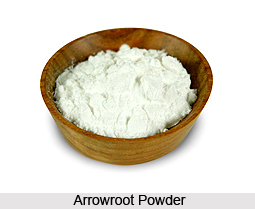 Botanical name:Curcuma zedoria Rosc.
Botanical name:Curcuma zedoria Rosc.
Family name:Zingiberaceae.
Indian names are as follows:
Hindi, Bengali, Sanskrit, Punjabi, Oriya etc:Sathi;
Meitei:Araru.
This plant is known commonly as Sathi in India. It is a small shrub that grows wild almost all over India. It is also cultivated for its rhizome. One of the variety is considered as a type of arrow root.
It is basically a root crop. The plant is a small shrub. Rhizome is oval shaped but curved like ginger. Leaves are long each 60 to 90 cm long. Inflorescence axis is 30 cm long, full of flowers. Flowers are white or yellow or indigo colored. Flowers appear during April/May and fruits thereafter.The branches coming out of the rhizome are dried and sold commercially as Sathi, while water-soluble portion of the entire rhizome is sold as arrowroot.
 The analysis of the rhizome gives 1.5% d-r-pinene, 3.5% d-canphane, 9.6% cineot, 4.2% d-camphor, 1.5% d-boneol, 10% sesquiterpenes, 48% sesquiterpene alcohols, and 21% residue. The flowers have nectar and pollen.
The analysis of the rhizome gives 1.5% d-r-pinene, 3.5% d-canphane, 9.6% cineot, 4.2% d-camphor, 1.5% d-boneol, 10% sesquiterpenes, 48% sesquiterpene alcohols, and 21% residue. The flowers have nectar and pollen.
Arrowroot is commonly used as spice and food additives. It is added in sweet dishes like puddings and bakery items. It is also added to vegetable, fish and meat dishes not only as spice for taste but also for thickening the gravy. It is, for this purpose commercially important all around the globe.
Sathi is known for its medicinal virtues in India since ancient period. Charaka Samhita suggested its application for treatment of cough, uterine fibrosis, and respiratory troubles. A standard medicine known as `Kanakayan gudikiya` needed for various gynecological disorders is prepared with Sathi as one of the important ingredient. In modern medicinal system application of both arrowroot and Sathi is well known. In folk systems too it is elaborately used.



